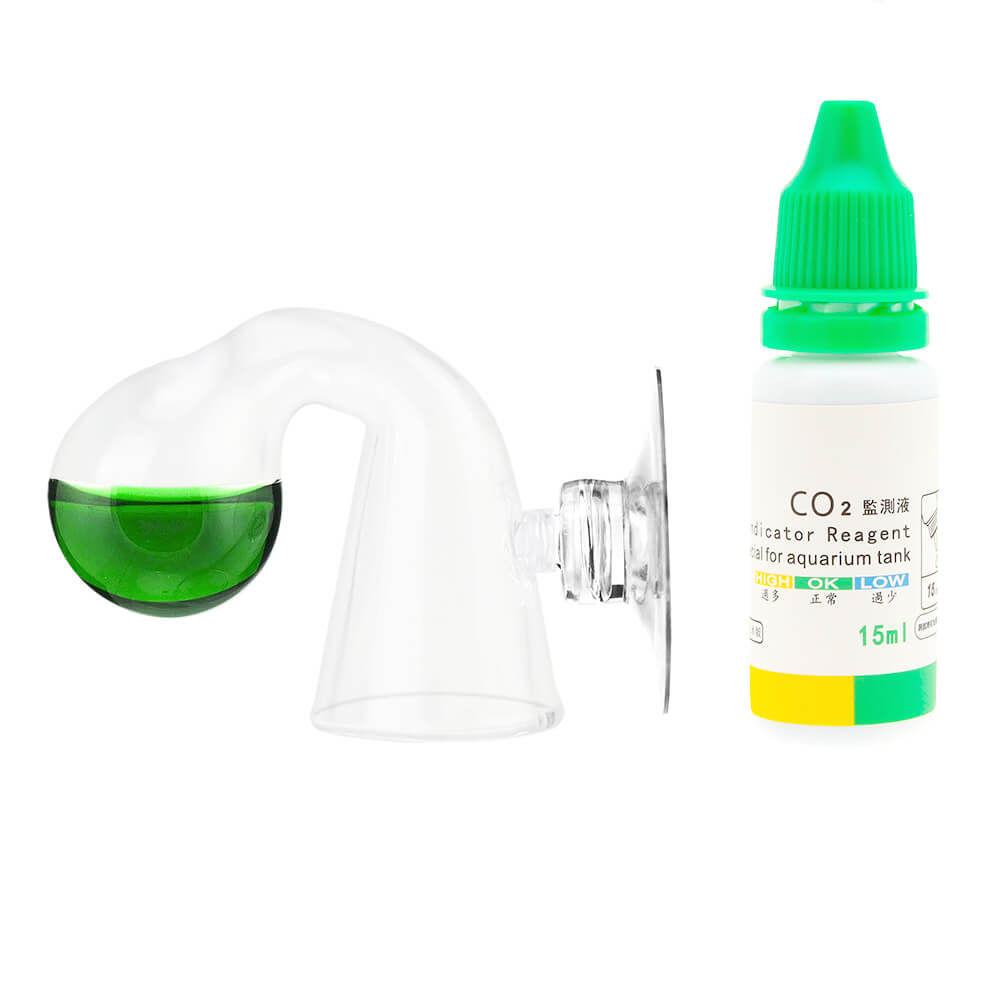By Lorraine | 19 March 2020 | 0 Comments
The CO2 Drop Checker
Although there is a statement like "long-term carbon dioxide indicator" on the package, the drop checker is just a set of pH testing tools. Many amateurs already have a pH test kit. Normally, if the water sample is alkaline, it will show blue (> pH7), if it is neutral, it will show green (= pH7), if it is acidic it will show yellow. These colors are typical when the reagent in the pH test kit is bromothymol blue. We hope that the drop checker can show us that the pH of the carbonized water in the tank is high enough to meet the needs of the plants but low enough to do no harm to the animals. Most people agree that the nominal concentration level for the high-brightness tank is around 30 ppm.

co2 drop checker for sale
The relationship between CO2, pH, and kH
When CO2 dissolves in water a small portion of it, less than about 0.2% combines with the water to form Carbonic Acid. As more CO2 dissolves and combines with water, the more the pH will drop. pH is an upside-down measurement A pH rise from 6 to 7 indicates a tenfold decrease in the acid concentration. A pH drop from 6 to 5 indicates a tenfold increase in acid concentration.kH is referred to as "carbonate hardness" and is a measure of the “equivalent” amount of carbonate and bicarbonate in the water. These are coincidentally the same type of products that occur as the Carbonic acid is formed by CO2 injection. If, however, the water already contains carbonates and bicarbonates, the effect is to neutralize the acid. Carbonate and bicarbonate, therefore, act as "buffers", to keep the pH higher even as more CO2 dissolves in the water. It is for this reason kH is also known as a measure of the "alkalinity" of water (alkalinity=high pH).
How to install your CO2 Drop Checker
Turn your drop checker upside down and fill the tank halfway with the CO2 drop checker indicator solution. Using a suction cup, immerse the drop checker in your fish tank water and stick it to the glass side of the fish tank. According to on the concentration of carbon dioxide in the water, the color of the solution changes.Check the colors. Blue = too low carbon dioxide concentration, yellow = too high carbon dioxide concentration (dangerous level for fish), green = optimal level for plants and fish. There is a 1-2 hour delay in color. What you are seeing now is the carbon dioxide concentration about 1-2 hours ago. Based on your reading, adjust your CO2 bubble rate using your regulator if needed. Wait another 2 hours for the carbon dioxide concentration to change and check your readings.
Usually, 1-3 bubbles per second through your bubble counter is enough to get a green reading tank up to 200 l. Adjust this according to what your tank size is and your drop checker indicates. If there are problems with your readings, then you are not diffusing enough carbon dioxide into the water. Try adjusting / increasing your circulation or repositioning the flow direction of your diffuser to help the diffusion rate. In addition, placing the diffuser near the filter inlet allows air bubbles to pass through the filter, improving the efficiency of carbon dioxide diffusion. The purpose of this is to keep the air bubbles in the water as long as possible to improve the efficiency of CO2 diffusion in the fish tank water. Make some small adjustments until you get a green reading on your drop check. Be careful not to go overboard and gas your fish.
By mastering the CO2 level in your fish tank, you can ensure that your fish has a healthy growth environment. We are proud to provide the best quality freshwater water tanks and aquarium supplies at the best prices. For more information or to make a purchase, please continue to visit our website senzeal.com or contact us immediately!
Leave a Reply
Your email address will not be published.Required fields are marked. *
CATEGORIES
- Aquarium Knowledge
- Aquarium Fishes
- Aquatic Plants
- Other Aquatic Creatures
- Best Aquarium Products
- Aquarium Light
- Aquarium Feeding Knowledge
- Fish Tank & Turtle Tank
- Aquarium Cleaning
- Fish Breeding
- Aquarium Heater
- Aquarium Filtration
- Planted Tank CO2
- Aquarium Decoration
- Shrimp Knowledge
- Aquascaping
- Algae
- Guppy
- Goldfish
- KOI
- Turtle
- Angelfish
- Betta
- Arowana
- Anemone
- Snails
- Fish Keeping
- Tropical

